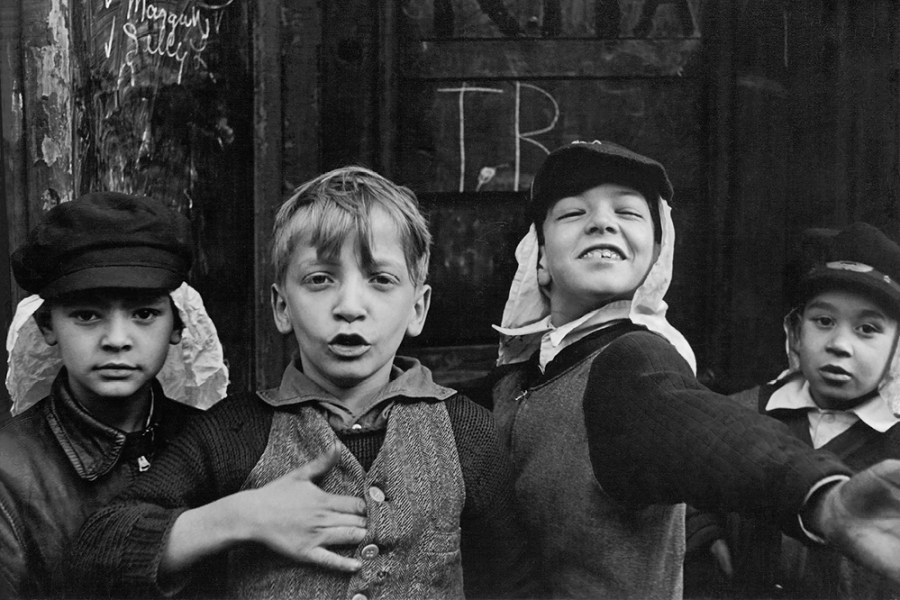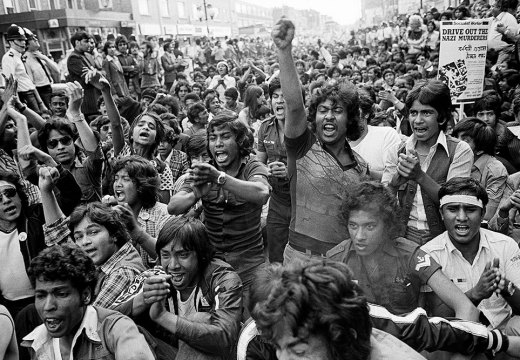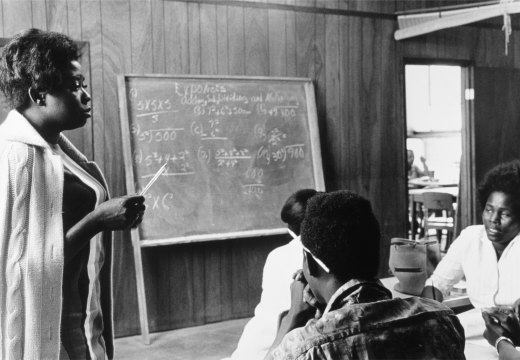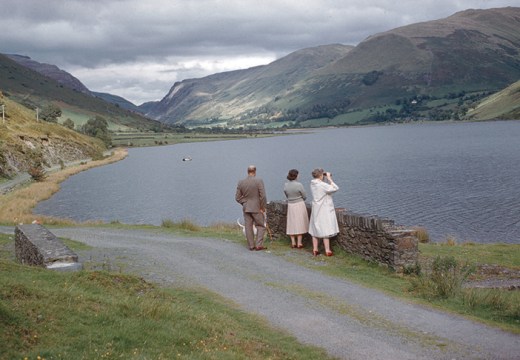Helen Levitt took photographs and made films for nearly 70 years, from the end of the Great Depression to the Clinton era, but her style and preoccupations remained as fixed as her terrain of East Harlem. Her subjects reach out to us through time like performers, the street ‘above all a theatre and a battleground’ according to her short film from 1948 that gives this exhibition at The Photographers’ Gallery its title. Curator Walter Moser’s careful selection of images makes the case for her formative role in street photography as we know it. The earliest work on display – pictures of children playing – is representative of what Levitt is famous for, with odd and off-kilter pictures favoured above more straightforward street scenes. With no adults in sight, boys and girls crowd confidently into the frame, contort their bodies into sculptural forms, poke heads out of rundown houses. There is always a compelling detail hinting at darkness or undercutting it. One of the most striking pictures is that of a young boy on a bicycle looking out of an empty mirror frame, glass shards being picked up on the other side by his playmates. The punctum is not the glass littering the curb, but the empty frame held by two boys like a paper hoop in a circus act.
The exhibition foregrounds Levitt’s interests in child psychology, modern dance, and silent film, moving away from the idea that her work was social documentary. Magazines in vitrines show that she was published from the start of her career, but there is a marked absence of material that suggests how she understood her own work. The curation divides the photographs by motifs, such as ‘Gestures’, and ‘The Street as Stage’. Surrealism is noted as an important influence, marginalising to an extent her long and fruitful partnerships with the altogether more documentary-minded photographer Walker Evans and writer James Agee. Her pictures of Mexico City’s poorer neighbourhoods, which she visited with Agee and where she took her only photographs outside of New York, adhere to the conventions of reportage and are mostly there to illustrate how much she otherwise departed from this mode.
Ultimately, the retrospective is keen to suggest that Levitt was mostly uncommitted to contemporaneous political and cultural movements, while giving us little insight into her own motivations. In the ‘Children at Play’ section, boys fight and turn street junk into weapons, the plaque on the wall suggesting the influence of war imagery on their imaginations. But if the street is a battleground, then the real war seems to be between children and adults. Families, so prominent in Dorothea Lange’s photographs of farm workers, are largely missing. In many of Levitt’s earliest images, adults and children stand apart, looking in opposite directions. The grown-ups seem exhausted, their tired clothing and dazed demeanours hinting at the economic crisis. At other times, they are themselves child-like. Levitt’s tone is hard to pin down: a humorous sequence from 1940 shows a drunken man lying in an abandoned carriage pram, the following five pictures filling up with concerned or amused passers-by, like a series of stills from a Marx Brothers film.

New York (1980), Helen Levitt. Courtesy Galerie Thomas Zander, Cologne; © Film Documents LLC
The most significant stylistic shift is Levitt’s turn to colour in the late 1950s. Most of these early images were stolen, so we have to leap forward to the ’70s and ’80s. Photographed in highly saturated reds, greens, and blues, New York City starts to look more familiar. There are fewer slums, and less space. Her subjects appear solitary and introspective, caught up in private fantasies. The playful chalk messages in the black-and-white pictures are replaced by clamorous advertising billboards. The violence grows; a man leers at a mannequin of a female torso, followed by another image showing a man raising his fists at it.
Early contact sheets show that Levitt interacted with the participants of her photographs, although her final prints rarely indicated this. In the colour photographs, her child subjects are less playful and more self-contained, perhaps hinting at a different approach: a girl in a floral dress, and a pot-bellied boy lean dreamily against red gumball machines; two children crammed and impatient on either side of a large woman making a call in a phone box. The women are lonelier-looking while remaining as stylish – with flowing hair and skin-tight synthetic clothes, instead of pompadours and boxy shoulders.

New York (1938), Helen Levitt. Courtesy Galerie Thomas Zander, Cologne; © Film Documents LLC
A decision to pair Levitt’s photographs of subway riders from the late 1930s and the ’80s emphasises continuity, however, even as it acknowledges that her methods changed. Levitt initially took inspiration from Evans in hiding her camera. The earlier subjects are arrested in sleep, which emphasises the covert nature of the photography. Later on, Levitt openly took pictures, but the awake passengers’ expressions appear as unguarded, as if Levitt had the ability to vanish herself as well as her camera. The hats and dresses of the elderly women in the second set make them look like time travellers from the older pictures. This focus on continuity further obscures any insight into how her motivations or creative ambitions might have developed over such a long period of time.
Her short film of children playing in East Harlem in 1948 was pulled together from rehearsed scenes that would have required her to command the non-actors, although it captures a spontaneity that now feels almost antiquated. Her self-erasure from the final images takes on a new significance in the context of this show. There are unexplored gaps such as the absence of any of the other critically lauded short films she collaborated on over 25 years of her career. The narrow focus and absence of biographical investigation further enlarges the biggest lacuna: the mystery of Levitt’s need to document the same streets and keep connecting, even as the world around her changed so dramatically.
‘Helen Levitt: In The Street’ is The Photographers’ Gallery, London, until 13 February 2022
Unlimited access from just $16 every 3 months
Subscribe to get unlimited and exclusive access to the top art stories, interviews and exhibition reviews.














![Masterpiece [Re]discovery 2022. Photo: Ben Fisher Photography, courtesy of Masterpiece London](http://www.apollo-magazine.com/wp-content/uploads/2022/07/MPL2022_4263.jpg)
Has the Fitzwilliam lost the hang of things?